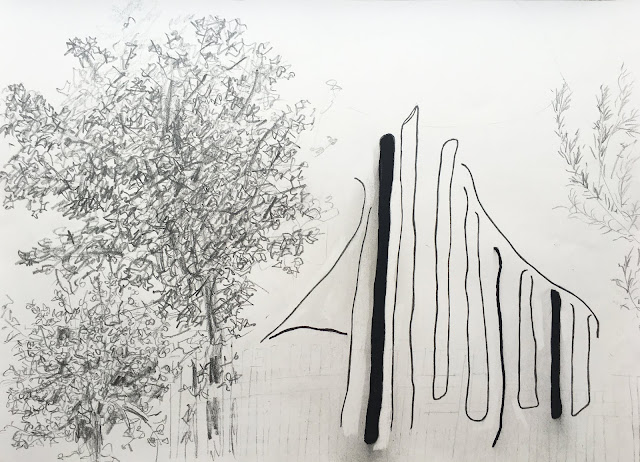As Blake outlines on the 52 Scores website, "Every day I am picking a piece of scrap paper to add to a weekly walking collage. After 7 additions the collage will form a walking score, i.e. instructions for walking. Each score will be finished on Friday, made public Saturday, and walked on Sunday."
As Nina and I had greatly enjoyed participating as remote walkers in some of Blake's previous walking projects, I immediately suggested joining him on one of the forthcoming walks. As we had planned a trip up country, to Da Lat in the Central Highlands, I thought that responding to one of Blake's walking scores would be the perfect way to discover and negotiate this small town that was completely new to us. Thus Sunday 2nd December became the assigned day of the walk, designated as score No. 5.
As the day approached I picked up the composed score on Instagram and sat down with a nice Vietnamese coffee to allow the collaged texts to trigger possibilities and suggestions.
Score No. 5 (Photo: Blake Morris, posted on Instagram)
The traditional nursery rhyme 'Do you know the Muffin Man?', sometimes also sang/recited as 'Have you seen the Muffin Man?', provided the motivation for the walk which therefore developed as a search with the phrase 'We need you!' adding a sense of urgency. The further clarification 'Dough Bake Assemble' helped to focus our attention on a search for small baked confections. The important element here of course being the local contextualisation of the guiding instructions, how to interpret the score within the local setting.
'Seven Magic mountains' supplied a suggestion for the number of the confections to discover, 'Ring' suggested that the search could be conducted around the periphery of the local Xuan Huong Lake, and the word 'Sunset', along with the accompanying photograph of the setting sun acted as a reminder that the search should be completed within the day. The exclamation 'Sings!' became meaningful as the walk commenced when a street food vendor cycled by broadcasting a recorded advertisement for his products recited in the local Vietnamese dialect, punctuated with musical inflections to add emphasis to each line.
Xuan Huong Lake at Da Lat (Google Maps)
The walk began with breakfast in a local bar/cafe called 'Woodstock', which suggested the famous song of 1971 by Crosby, Stills and Nash pilgrimage describing a musical pilgrimage to the famous concert in 1969. Of course our 'pilgrimage' today was not toward 'Woodstock' but away from it though the connection put a smile on our face and the lovely cafe also provided our first confection of the day.
Woodstock bar/cafe, Da Lat (Photo: Patrick S. Ford)
Croissants / pastries - section for breakfast (Photo: Patrick S. Ford)
After breakfast in Woodstock our walk continued downhill toward the lake and along to Da Lat Market where a rich vein of delicious and sometimes mysterious confections were found.
Da Lat Confections (Photo: Patrick S. Ford)
Da Lat Confections (Photo: Patrick S. Ford)
Da Lat Confections (Photo: Patrick S. Ford)
Da Lat Confections (Photo: Patrick S. Ford)
Da Lat Confections (Photo: Patrick S. Ford)
Da Lat Confections (Photo: Patrick S. Ford)
The search for confections lead us through the streets and markets of Da Lat, around the lake and our discoveries are recorded in the photographs posted here. The walk could have had other focuses: fruit, drinks, local basket-ware crafts, clothes, flowers etc. and each one of these topics could have resulted in alternative experiences of Da Lat.
At the end of the afternoon, the sun dropped to the western end of the lake, closing the day's explorations. The orientation of the lake provides picturesque sunsets, especially when viewed from one of the lake-side restaurants. This was a great way to become familiar with Da Lat and once again, Blake's walking projects have provided an unforgettable and rewarding experience.
Sunset over Xuan Huong Lake, Da Lat (Photo: Patrick S. Ford)


















